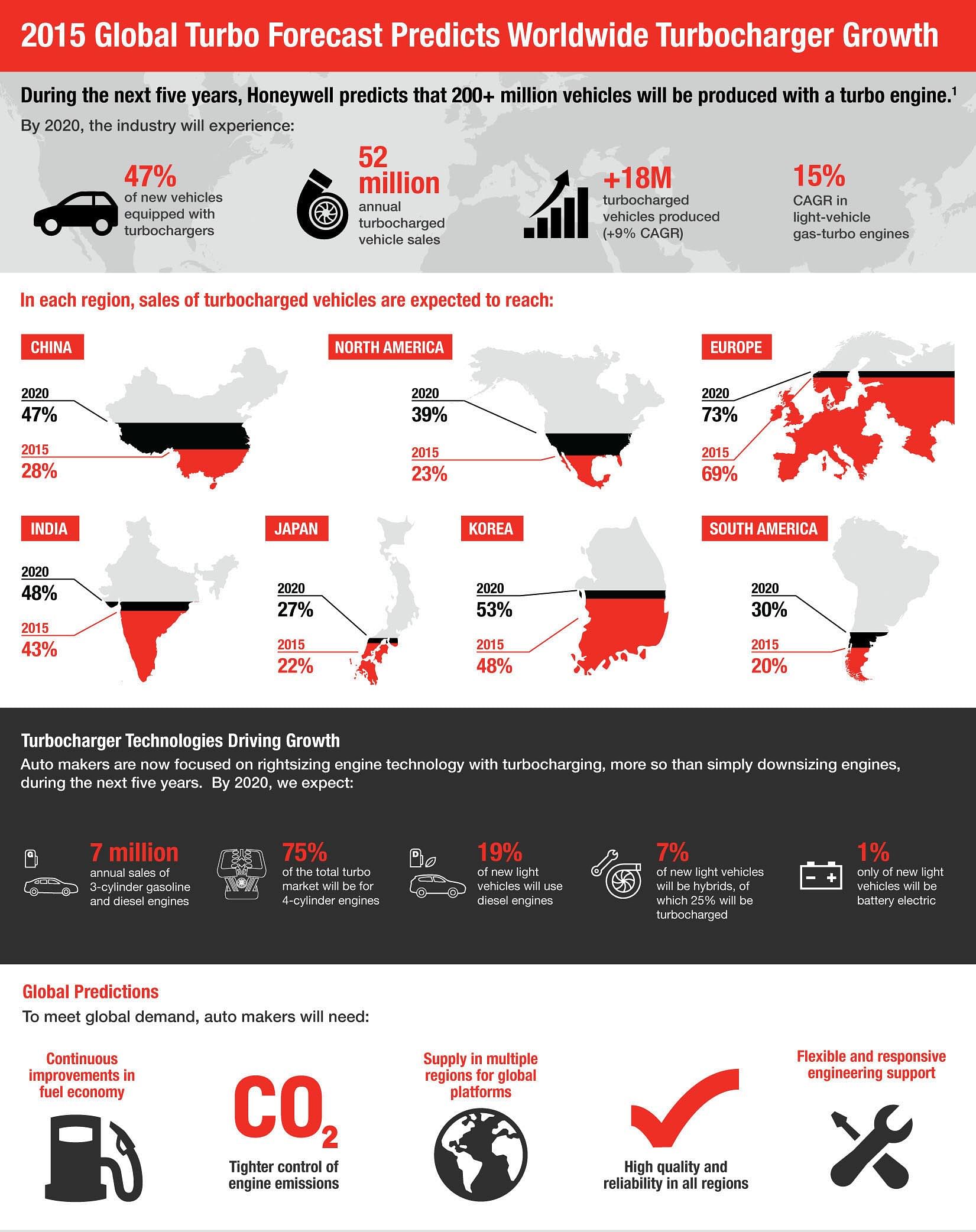By 2020, 47% of all new vehicles globally to be fitted with turbochargers
Honeywell's 2015 turbocharger forecast signals increased expectations of turbo technology as global penetration nears 50 percent by 2020
A just-released report from Honeywell, the global developer of automotive turbochargers, has predicted worldwide turbocharger growth. The company has forecast that over 200 million vehicles will be produced with a turbo engine.
The company sees the evolving needs of automakers driving not only turbo adoption globally to 47 percent by 2020, but an increasing appetite for turbo technology innovations that enhance a vehicle's overall powertrain system, reduce complexity and are tailored to local market needs.
The biggest growth will be seen in China, from 28% in 2015 to 47% of all new vehicles by 2020. In comparison, in India, demand is slated to grow from 43% in 2015 to 48% in 2020.
Honeywell unveiled its annual survey in advance of the Frankfurt Motor Show (IAA) where the next evolution of turbocharger applications can be seen in diesel, petrol and hybrid models from entry level to luxury segments.
According to the survey, automakers are focused on rightsizing engine technology, more than simply downsizing engines, to optimise vehicle performance and fuel economy as global regulations continue to drive more fuel efficiency.
"The golden age of turbo is gathering momentum globally as the industry numbers indicate," said Terrence Hahn, Honeywell Transportation Systems president and CEO. "But there is a clear demand for more sophisticated turbo technology that covers the entire powertrain performance envelope. Automakers are turning to suppliers like Honeywell to meet the unique needs of fuel-efficient 3-cylinder engines, increase power from 4-cylinder engines with advanced aerodynamics, and soon deliver electric boosting and energy recovery systems for advanced hybrid powertrains."
Technology themes of Honeywell's 2015 forecast
- Adoption of turbocharged 3-cylinder petrol and diesel engines is emerging as a huge growth trend globally for fuel efficient entry-level and mid-range vehicles. Honeywell sees an industry compound average growth rate (CAGR) of 30 percent through 2020 resulting in sales of 7 million 3-cylinder turbocharged engines by 2020. The company’s Gen3 gasoline turbocharger range is optimised to withstand the higher loads generated by the 3-cylinder configuration.
- Globally, 4-cylinder engines will continue to represent 75 percent of the turbocharged light vehicle industry in 2020. Honeywell forecasts this turbo engine family will have a 7 percent CAGR through 2020. For this category, Honeywell technologies such as variable geometry (VNT), Twin Scroll, Mixed-Flow, Ball Bearings and DualBoost will help auto makers improve engine power without sacrificing transient response.
- Multi-stage boosting for diesel engines is another key innovation to help automakers achieve greater engine performance, without breaching fuel economy regulations. By 2020 more than 2 million light new vehicles per year will be launched with multi-stage boosting systems. Honeywell says it is preparing to launch the industry's first two-stage application with two variable geometry turbos combined in series for ultimate power density and response.
- Globally, diesel engines will retain an important share of light vehicle sales at nearly 20 percent, due to their lower fuel consumption and CO2 emissions. Honeywell expects diesel penetration to double in North America to 7 percent by 2020, enabled by the latest clean diesel turbocharging and after-treatment technologies.
- Penetration of hybrid powertrains, including 'plug-ins', will be up 4 points to 7 percent of the global light vehicle market. Approximately 25 percent of these vehicles will use turbocharged engines, compared to 10 percent today, opening the door to potential future enhancement with electric boosting and energy recovery.
- In contrast, battery electric vehicles are expected to be only 1 percent of global light vehicle sales in 2020 due to high battery costs and limited range between charges.

RELATED ARTICLES
Sept 2024 From R&D incentives to EV infrastructure: What auto components industry expects from Budget 2024
Sept 2024 From R&D incentives to EV infrastructure: What auto components industry expects from Budget 2024
US car majors hit the brakes on driverless cars
Ford Motor and Volkswagen to close self-driving startup Argo AI, due to lack of technology and clear regulations.
Autoliv and Geely to develop advanced safety tech for future vehicles
Scope of cooperation includes safety for high-level autonomous driving, intelligent steering wheel technology, a 360deg ...






 By Autocar Pro News Desk
By Autocar Pro News Desk
 18 Sep 2015
18 Sep 2015
 3511 Views
3511 Views









